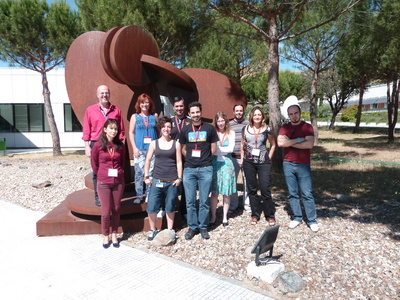2014 SAS Workshop - XMM-Newton
SAS Workshop 2014: Learning to see with X-ray vision
SAS Workshop 2014: Learning to see with X-ray vision
ESA's XMM-Newton has been observing the X-ray universe for almost fifteen years, greatly boosting high-energy astronomy. But the legacy of XMM-Newton also has a human side; around 200 astronomers from many different countries have learnt to deal with X-ray data thanks to an XMM-Newton workshop that has become a tradition; one that keeps attracting the same number of participants even after 14 years. Matteo Guainazzi (MG) and Ignacio de la Calle (IC), together with their colleagues, are its organisers.
The XMM-Newton Science Analysis System (SAS) Workshop has been an annual event at ESAC since 2000. Its aim is to help XMM-Newton users to learn how to manipulate and analyse XMM-Newton data. This 5-day workshop, that took place this year between 2nd-6th of June, is split between presentations by XMM-Newton SOC members, and hands-on training sessions.
A whole new generation of astronomers have learnt X-ray astronomy with your help. How many people have benefitted from the SAS workshops?
MG and IC: We have designed these workshops to be very interactive and with intensive and personalized attention received by every participant from SOC people. With this objective in mind, we have restricted the attendance to 20 participants for each workshop. Generally we have had between 15 and 20 participants at each of the 14 events so far. This number has remained very stable over the years. They come mostly, but not exclusively, from Europe.
Do you see changes in the participants, or in their questions and interests?
MG and IC: Although the SAS Workshops are useful to experienced astronomers, they primarily attract young researchers, since they provide a solid introduction to the field of X-ray astronomy. The goals and expectations of these young participants have not changed significantly over the years. At the end of the workshop they are ready (and willing) to be able to make their first independent steps towards developing their own research projects using X-ray astronomy.
How has x-ray astronomy evolved since the launch of XMM-Newton?
MG: X-ray astronomy is now a fully mature branch of astronomy. No physical view of any celestial source can be self-consistent and complete if it does not take into account the emission in the high-energy electromagnetic spectrum. There is almost no celestial source in the sky that can be considered X-ray silent.
The number of participants in the SAS Workshops has not decreased, even after 14 years. Does it mean XMM-Newton is still very much in demand?
IC: XMM-Newton has played an important role in developing X-ray astronomy. Even after 14 years, the time requested for observations with XMM-Newton is over five times higher than the available time. This shows that great science can still be done with this space observatory. As participants in the workshop go back to their home institutions they can spread what they have learned, widening even more the knowledge of the instruments and the analysis of the data they collect.
Do you keep track of the students after the workshops?
MG and IC: We know that a sizeable fraction of the participants who attended without prior experience with high-energy astronomy data are now actively working in the high-energy astronomy field.
For young astronomers who have grown up with XMM-Newton, will their experience be useful with future X-ray missions?
MG: The future of this field is more and more geared towards launching instruments with higher energy resolution and wider imaging energy bandpass, to be better able to measure with more accuracy the dynamics and physical diagnostics of astrophysical plasmas in stars, galaxies and in the far Universe. ESA's future X-ray observatory, recently approved as "L-class" mission, will allow the current SAS Workshop participants to study previously unexplored physical regimes.
What have you learnt from the courses?
MG: Dealing with young scientists coming from all over the world during such an intense Workshop is extremely important for us to tune and improve our support to the astronomical community.
IC: It is important to see first-hand what problems people have when analysing XMM-Newton data. And of course it is always rewarding to see that your efforts are not wasted and that, after so many years, people are still eager to learn how to analyse XMM-Newton data.
- Removed a total of (1) style text-align:center;
- Removed a total of (1) style float:right;
- Removed a total of (1) align=left.
- Removed a total of (1) border attribute.
- Converted a total of (1) center to div.








































 Sign in
Sign in
 Science & Technology
Science & Technology
